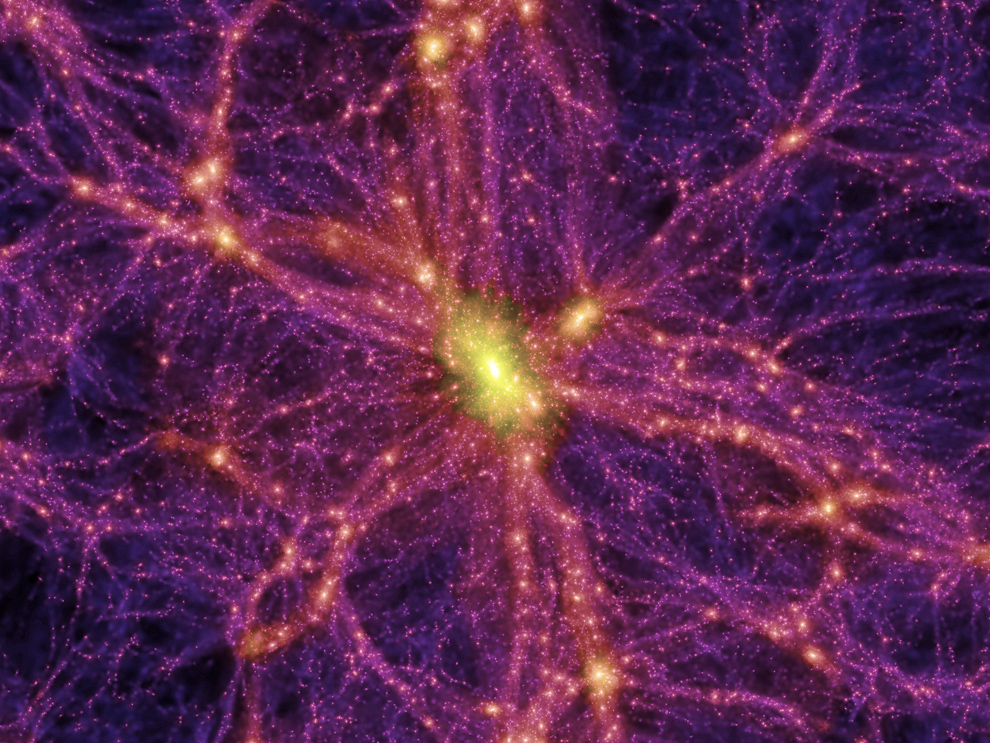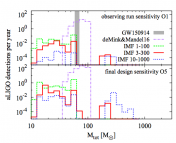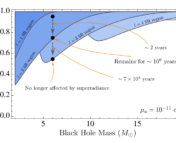Title: Did LIGO Detect Dark Matter?
Authors: Simeon Bird, Ilias Cholis, Julian B. Muñoz, Yacine Ali-Haïmoud, Marc Kamionkowski, Ely D. Kovetz, Alvise Raccanelli, Adam G. Riess
First Author’s Institution: Department of Physics and Astronomy, Johns Hopkins University
Status: Published in Physical Review Letters, Open Access
The mystery of the nature of dark matter is deepening. Dark matter particles have evaded our detection again and again, bringing into question the most popular theories (like WIMPS), and thereby opening the door to more exotic and unexpected dark matter models. In the midst of this growing uncertainty, a new possibility has arisen. LIGO has detected gravitational waves resulting from the merging of two black holes. This may seem irrelevant to dark matter, but black holes are really not unreasonable dark matter candidates. They don’t emit light, and they definitely do interact via gravity, and those are basically the only two things we know about dark matter.
The LIGO black holes have revived the idea of larger-than-particle dark matter, called MACHOs (Massive Astrophysical Compact Halo Objects). MACHOs are large, dark objects that are not made up of smaller fundamental dark matter particles, but actually act as the dark matter “particles” themselves. (Read more about them in this astrobite.) In the past, this kind of dark matter was a popular alternative to particle dark matter, but many years of work revealed that most sizes of these larger dark matter objects would disrupt the Universe in some way, leaving it different than the true Universe that we observe.
For example, black holes with masses around that of an individual star would have given themselves away in searches for the bending of starlight in their gravitational field (an effect called microlensing – read more about it in this astrobite). More massive black holes would have left an imprint on the early Universe that would show up in the Cosmic Microwave Background (read more about the “CMB” here). These are only two examples of the many ways in which astrophysical observations tell us which masses are not possible for MACHOs (Figure 1). One mass that could be possible, is about 30 times the mass of the sun. It just so happens that LIGO has detected black holes of this mass!

Figure 1. The ruled out black hole MACHO masses from astrophysical observations. The x-axis is the mass of the black hole (in units of solar masses), and the y-axis is the fraction of dark matter that is made up of black holes. Each colored line surrounds a range of masses that has been ruled out (with more masses ruled out when black holes make up a larger fraction of dark matter). The black dashed line labeled PBH (Primordial Black Hole) is the allowed region in which the LIGO black holes fall. Source: Clesse et al, 2015.
The question then, is whether black hole dark matter is really consistent with the black hole mergers observed by LIGO. The first step – confirming that LIGO has detected black holes with the correct mass – is all set. The next step is not so simple. LIGO must detect black hole collisions that correspond to the known properties of dark matter.
We know that dark matter was an important part of the evolution of the early Universe, meaning that dark matter black holes must have existed at this time, and therefore cannot be typical stellar black holes that form in the death of massive stars. They must be a type of black hole that forms much earlier, referred to as “primordial black holes.”
So how do we tell whether LIGO is detecting stellar black holes or primordial black holes? The primary difference between them (apart from their origin) is their location. Stellar black holes should exist in regions with lots of stars, while primordial black holes should exist in regions with lots of dark matter. There is overlap between these regions, but they are not identical.
Primordial black holes, if they really are dark matter, have an additional constraint. They do not only need to exist in the known locations of dark matter, they must also exist in known quantities. We know quite a bit about the mass of dark matter halos around galaxies and galaxy clusters (Figure 2), so if we want primordial black holes to explain all of that dark matter, we have a pretty good idea of how many primordial black holes there must be.

Figure 2. The simulated spatial distribution of dark matter around a galaxy cluster. Brighter regions have higher density of dark matter, and therefore would have more primordial black hole mergers. Source: National Geographic and Volker Springel, et al.
Currently, it’s pretty difficult to tell exactly where a gravitational wave is coming from, so it’s not possible to say whether the black hole collisions happen in regions with lots of stars or lots of dark matter. The way to tell whether LIGO black holes could possibly be primordial black hole dark matter is to see whether the rate of LIGO observations matches up with the expected rate of primordial black hole collisions.
This is exactly the topic of today’s paper. The authors predict the rate of primordial black hole collisions and compare it to the LIGO observations. The predicted collision rate depends on the quantity of primordial black holes and their spatial distribution (regions of higher density have higher collision rates). Since this requires a precise knowledge of the spatial distribution of invisible matter, the prediction is quite approximate, but the authors do their best to use observations and simulations to make realistic assumptions about the shape and mass of dark matter halos. They find that the expected rate of primordial black hole mergers (Figure 3) is in fact consistent with the rate inferred from LIGO observations. Although this result is very approximate and certainly doesn’t rule out stellar black holes, it means that primordial black hole dark matter is a possibility!

Figure 3. The rate of primordial black hole mergers per dark matter halo, as a function of halo mass (in units of solar masses). The two lines use different theories of dark matter halo structure. Source: Figure 2 in the paper.
As LIGO continues to detect more and more gravitational wave signals, we will be able to learn more about the rate of black hole collisions and the possibility of dark matter black holes. Additionally, as more gravitational wave detectors start collecting data, we will have more precise information on the location of each black hole merger. This will allow for a comparison between the spatial distribution of black holes and the relative spatial distributions of dark matter and stars. Even though all this sounds extremely complicated, and maybe a bit unlikely, it’s awesome that the seemingly unrelated detection of gravitational waves has opened the door to discussions of new theories of dark matter.





Hi, this was very interesting. I wish I could remember where I read this, but another article I read came at this from the other direction. If I remember correctly, the black holes that collided are known as Intermediate mass black holes. These have been very hard to detect thus far, and theories about how they would form WITHOUT being primordial would imply that they are very rare. In that case, the chance that two of them would collide is vanishingly small. Therefore, the LIGO detection itself implies that they are almost certainly primordial. No other formation theory would allow for two of them being close enough to merge with any likelihood at all.
With the announcement of yet another merger in August the frequency seems to imply lots and lots of 10-50 solar mass BHs. The latest observation also included the VIRGO instrument thus narrowing dramatically the positioning. An exciting new development in Dark Matter astrophysics.
I’m an old guy who studied many years before concepts of dark matter. I was curious about the possibility of BH’s accounting for the missing dark matter. I believe we can only detect BH’s from a direct shot of Hawking radiation, spacial lensing, and halos. The first is improbable. I’m not sure how well we can detect lensing . The halo is probably our easiest method. I wonder whether 2 BH’s which collide might not first strip each other’s halos, making the job of detection very problematic .
LIGO detects black hole collisions by detecting the gravitational ripples caused by the massive disturbance.